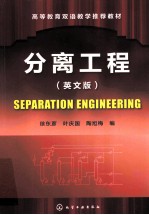

分离工程 英文版PDF电子书下载
- 电子书积分:11 积分如何计算积分?
- 作 者:徐东彦,叶庆国,陶旭梅编
- 出 版 社:北京:化学工业出版社
- 出版年份:2012
- ISBN:9787122129109
- 页数:256 页
Chapter 1 Separation Processes 1
1.1 Characteristics of separation process and separation factor 2
1.1.1 Characteristics of separation process 2
1.1.2 Separation factor 5
1.2 Classifications of separation process 6
1.3 Selection of separation processes 8
1.4 Industrial chemical processes 9
Words 12
Notes 13
Problems 14
References 15
Chapter 2 Foundation of Multicomponent,Multistage Separations 16
2.1 Degree of freedom and design variables 16
2.1.1 General description 16
2.1.2 Design and control degrees of freedom 21
2.1.3 Phase rule and the degree of freedom analysis of processes 22
2.2 Calculation of phase equilibrium 24
2.2.1 Phase equilibrium 24
2.2.2 Phase equilibrium data 26
2.2.3 Calculations of vapor-liquid equilibrium 28
2.3 Multicomponent bubble-and dew-point calculations 35
2.4 Single stage equilibrium calculations 37
2.4.1 Determination of phase conditions for a mixture and types of flash distillation calculations 38
2.4.2 Isothermal flash 39
2.4.3 Adiabatic flash 42
2.5 Batch distillation 43
2.5.1 Introduction 43
2.5.2 Unconventional column configurations 45
2.5.3 Batch distillation optimization 46
2.6 Steam distillation 46
2.7 Continuous distillation 47
Words 49
Notes 50
Problems 52
References 54
Chapter 3 Multicomponent,Multistage Separations 55
3.1 Multicomponent distillation 55
3.1.1 Key components 56
3.1.2 Complex of multicomponent distillation 57
3.2 Fenske-Underwood-Gilliland shortcut method 58
3.2.1 Material balance method of sharp separation 59
3.2.2 Fenske equation for minimum equilibrium stages 63
3.2.3 Underwood formula for minimum reflux ratio 67
3.2.4 Gilliland correlation for actual reflux ratio and theoretical stages 69
3.2.5 Feed-stage location 70
3.3 Azeotropic distillation 71
3.3.1 Azeotropism 71
3.3.2 Characteristics of azeotrope 73
3.3.3 Azeotropic distillation processes 73
3.3.4 Azeotropic distillation using an entrainer 77
3.4 Extractive distillation 79
3.4.1 Introduction 79
3.4.2 Principles of extractive distillation 80
3.4.3 Analysis of extractive distillation process 82
3.5 Salt distillation 84
Words 86
Notes 87
Problems 89
References 91
Chapter 4 Gas Absorption and Stripping 92
4.1 Introduction 92
4.2 Gas-liquid equilibrium 93
4.2.1 Equilibrium of physical absorption 93
4.2.2 Equilibrium of chemical absorption 94
4.3 Absorption and stripping process 95
4.3.1 Introduction of absorption and stripping process 95
4.3.2 Analysis of multicomponent absorption and stripping process 97
4.4 Shortcut calculation of multicomponent absorption and stripping process 100
4.4.1 Basic conception of absorption process calculation 101
4.4.2 Absorption factor method 102
4.4.3 Stripping factor method 112
Words 113
Notes 113
Problems 114
References 116
Chapter 5 Rigorous Methods for Multicomponent,Multistage Separations 117
5.1 Theoretical model for an equilibrium stage 117
5.1.1 Physical model of complex distillation column 117
5.1.2 Theoretical model of equilibrium stage 118
5.2 General strategy of mathematical solution 121
5.3 Equation-tearing procedures 121
5.3.1 Tridiagonal-matrix algorithm 122
5.3.2 Bubble-point (BP) method 124
5.3.3 Sum-rates (SR)method 127
5.3.4 Simultaneous-correction method 128
5.4 Stage-by-stage method 128
5.4.1 Starting point of calculation 128
5.4.2 Calculation at constant molar overflow 129
5.4.3 Determination of feed stage and the criteria for the end of calculation 131
5.4.4 Calculation at varying molar overflow 133
Words 140
Notes 141
Problems 142
References 143
Chapter 6 Efficiency and Energy Saving in Distillation Process 145
6.1 Efficiency 145
6.1.1 Types of plate efficiency 146
6.1.2 Factors impacting efficiency 148
6.1.3 Efficiency calculation methods 152
6.1.4 Overall efficiency evaluation of commercial distillation columns 153
6.2 Minimum work of separation process 153
6.2.1 General description 153
6.2.2 Minimum work of separation 154
6.2.3 Nonisothermal separation and available energy 157
6.2.4 Net work consumption and thermodynamic efficiency 158
6.3 Energy saving in distillation process 159
6.3.1 Thermodynamic analysis of separation process 159
6.3.2 Distillation with intermediate condenser and reboiler 160
6.3.3 Multi-effect distillation 160
6.3.4 Heat pump 165
6.4 Distillation sequencing 166
6.4.1 Distillation sequencing using simple columns 166
6.4.2 Practical constraints restricting options 169
6.4.3 Choice of sequence for simple nonintegrated distillation columns 170
6.4.4 Distillation sequencing using columns with more than two products 170
6.5 Synthesis of separation processes by case-based reasoning 171
6.5.1 Selection of single separations 172
6.5.2 Synthesis of azeotropic separations 173
6.5.3 Synthesis of separation sequences 174
6.5.4 Combined operations 175
6.5.5 Examples on azeotropic separation 176
6.6 Design and optimization of thermally coupled distillation schemes 177
6.7 Energy efficiency of an indirect.thermally coupled distillation sequence 180
Words 184
Notes 185
Problems 186
References 188
Chapter 7 Other Separation Methods 189
7.1 Adsorption 189
7.1.1 Adsorbents 191
7.1.2 Fundamentals of adsorption equilibria 194
7.1.3 Theories of adsorption equilibria 195
7.1.4 Processes and cycles 198
7.1.5 Application in carbon dioxide separation 204
7.2 Ion exchange 206
7.2.1 Structure of ion exchange resins 206
7.2.2 Principles of ion exchange processes 208
7.2.3 Type of ion exchange resins 210
7.2.4 Application of ion exchange resins 211
7.2.5 Regeneration of ion exchange resins 215
7.3 Liquid-liquid extraction 215
7.3.1 Solvent selection 216
7.3.2 Extractor design 218
7.3.3 Liquid-liquid extraction equipment 220
7.3.4 Supercritical fluid extraction 223
7.4 Reactive distillation 228
7.4.1 Introduction 228
7.4.2 Basic of reactive distillation 228
7.4.3 Available commercial catalytic packings and homogeneous internals 231
7.4.4 Barriers to commercial implementation 231
7.4.5 Computational methods 232
7.4.6 Application 233
7.5 Membrane separation 241
7.5.1 Introduction 241
7.5.2 Membranes for gas separation 241
7.5.3 Membranes for liquid separation 245
Words 248
Notes 251
Problems 254
References 254
- 《市政工程基础》杨岚编著 2009
- 《工程静力学》王科盛主编 2019
- 《中央财政支持提升专业服务产业发展能力项目水利工程专业课程建设成果 设施农业工程技术》赵英编 2018
- 《化学反应工程》许志美主编 2019
- 《卓有成效的管理者 中英文双语版》(美)彼得·德鲁克许是祥译;那国毅审校 2019
- 《绿色过程工程与清洁生产技术 张懿院士论文集精选 上》《绿色过程工程与清洁生产技术》编写组编 2019
- 《软件工程》齐治昌,谭庆平,宁洪编著 2019
- 《化学工程与工艺专业实验指导》郭跃萍主编 2019
- 《AutoCAD 2018自学视频教程 标准版 中文版》CAD/CAM/CAE技术联盟 2019
- 《跟孩子一起看图学英文》张紫颖著 2019
- 《山东梆子》田和灵,叶健,赵艳喜编著 2019
- 《长三角雾霾突发事件风险评估、应急决策及联动防治机制研究》叶春明著 2019
- 《事略稿本 74(民国三十七年四月至五月)》叶惠芬编辑 2013
- 《蒋中正总统档案 73 (民国三十七年二月(下)至三月)》叶惠芬编辑 2013
- 《蒋中正总统档案 58 (民国三十三年八月至十月)》叶惠芬编辑 2011
- 《蒋中正总统档案 59 (民国三十三年十一月至三十四年二月)》叶惠芬编辑 2011
- 《万物有核》徐东著 2019
- 《叶秀山全集 第3卷》叶秀山著 2019
- 《蒋中正总统档案 57 (民国三十三年五月至七月)》叶惠芬编辑 2011
- 《少数民族作家海外推广系列 唐卡之书》张显奎,范伟责任编辑;(美)Scott Ian Rainen,(英)Jack Hargreaves译;叶多多 2019
